After our recent week in Tuscany with family
and friends (20, in case you haven’t been reading), Mark and I wanted some
“us” time. So off we
went to Rome, where we rented a very tiny studio apartment for a week in
Vecchia Roma – on the Via dei Coronari, about two minutes from Piazza Navona
and another five minutes to Campo dei Fiori. If you’ve been to Rome, you
already know that Campo dei Fiori is foodie heaven. If you haven’t been, it is
definitely the place to go if you love good food.
Our neighborhood was filled with high-end
antiques shops, upscale men’s clothing boutiques, restaurants and caffès. When I looked out the window in the morning and evening, the
sun would stream down this vicolo
and make amazing shadow play on the centuries-old stuccoed walls, as I watched
people coming and going.
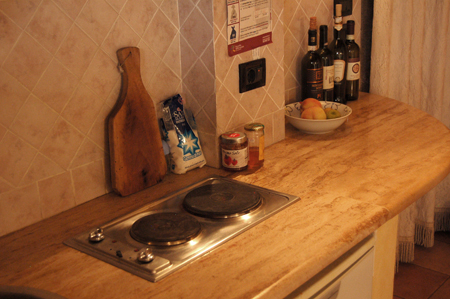 |
| A tiny but very efficient kitchen! |
When we rented it, we were happy to find it was on a “pedestrian only” street, thinking it would be quiet. But, now, we almost
believe that quiet is impossible in Rome. In the end, “pedestrian only” meant pedestrians, cabs, trucks, motorcycles, and hand carts – all on cobbles. But it didn’t matter – the life below was part of the magical
experience. So what if we lost a
little sleep at night?
Every day – even Sundays now – there are
dozens of vendors selling their produce and wares in the Campo dei Fiori. The Sunday vendors mostly sell dried
and packaged ingredients – spices, herb mixtures, oils, vinegars, legumes and nuts. But every other day there is an amazing
array of fruits, vegetables and flowers that made me practically giddy.
One of my many faults, as Mark will gladly
tell you, is over-buying at markets, especially when in Europe. There are so
many foods I want to try and, in my mind, I have plenty of time to make all
the things of which I dream. He
gets frustrated when we end up needing to get rid of things before flying back
stateside. This time, I promised to show some restraint.
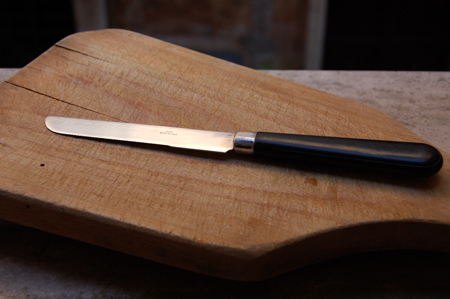 |
| The apartment had but two butter knives – it’s amazing what can be done with them! |
We actually spent the nicest first
evening in Rome at the Bar Campo de’Fiori, sipping Campari (me) and Cynar
(Mark) cocktails and watching the delightful parade of life go by to the music
of a very talented classical guitarist. It wasn’t until several days later that
we got there at 6:30am to buy produce for meals at the apartment. Already I
felt more restrained!
We started the market visit by touring
around, checking out each vendor and her/his offerings. Beautiful wines,
cheeses, honeys, vinegars, grains, spices, flowers and, of course, vegetables
and fruits. Being that it is mid-September, I was hopeful that it might just be
the beginning of porcini season, but our once-over revealed only standard white
button mushrooms. Sad, but I would survive.
We hadn’t really thought much about what we
wanted and started looking at one vendor who had green beans that were as thin
spaghetti strands. I love haricots verts,
but these were a new extreme in their minuscule size. The somewhat older, yet
spritely, woman behind the stand quickly threw us several bags to fill. Her daughter soon came by and asked if
we needed anything else.
We asked
her to choose a melon for us, one that would be good for the next day. She squeezed a few, settled on one,
sniffed both ends and added it to our pile. We started to put some white peaches in a bag and she
stopped us, telling us to get the “giallone”
ones in the next bin. Not your
average yellow peach, she said- “This one is special in Rome – we have it
for dessert in a wine glass with a slightly frizzante
wine.” She said prosecco
would be perfect. We told her that
we had a nice verdicchio on hand and she said, “Va bene!” That would be fine.
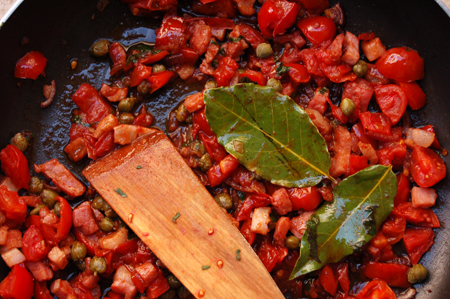
Just before finishing up, I asked her,
“Quando e la staggione per i funghi
porcini?” When is the
season for porcini? “Adesso! Now!” she replied both in
Italian and English. She walked
over to the neighboring vendor and returned a moment later, her hands filled
with the beautiful, fragrant, bulbous, gritty mushrooms.
I was so happy that I thought to ask! She asked how many we wanted and I asked for two large
ones. She wrapped them in paper
and then held up a bunch of parsley, asking if we needed any. It was her subtle hint that parsley is
the herb of choice for these mushrooms.
We added the parsley to the pile.
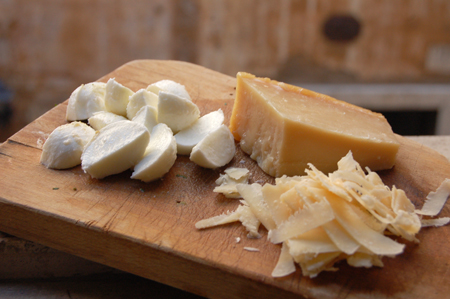
So we left that day with our two prized
porcini, a melon, yellow peaches, figs, itsy-bitsy green beans, onions, parsley
and basil. (We went back two days
later for more porcini, another melon, figs and peaches…). My afternoon’s
amusement lay ahead… Cooking and photographing our market treasures. (Here I must
say that the only downside to the apartment was its north-facing exposure – it
made for very bad photography lighting.
So the photos are not optimal to say the least!)
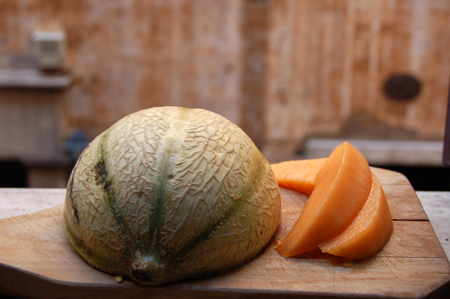
The first real meal in the apartment
consisted of slices of fresh melon, sautéed porcini with parsley, sautéed fagiolini (green beans) with rosemary (brought with us from the villa outside Cortona),
slices of bresaola (a cured beef) with arugula and Parmigiano-Reggiano, pasta with pancetta, onions,
tomatoes, capers and red wine topped with fresh mozzarella and Parmigiano-Reggiano. We drank a Rosso di Montefalco with dinner and then had a few fresh
green figs and finished with yellow peaches in verdicchio. We were stuffed to the gills – it had been enough food for six people! What? Were we supposed to stop when we were full?

As many times as I have had pasta with
“fresh” porcini in my life, I have come to the realization that there
is nothing – absolutely nothing – as good as a simply sautéed porcini mushroom
by itself. The caps melt in your
mouth like foie gras (without the calories or political guilt) and the stems
are as good as the best steak I have ever eaten. Mark said, “For 17 years I have heard you go on about
fresh porcini mushrooms. I could
never see what the big deal was…
Until now!“
The following recipes are less like recipes and more like guidelines. That is the way we cook when we are in Italy. As porcini mushrooms (boletus edulis) are very hard to find fresh in the States, American-made bresaola is over-dried, and giallone peaches may not be grown here, you may need to substitute with your local ingredients: portobello mushrooms for the porcini, prosciutto or speck for the bresaola and the freshest local peaches for the giallone. The shape of the pasta we used (radiatore) is probably all wrong for the sauce we made (Italians are quite clear that each shape of pasta – and there are hundreds – is meant for a particular sauce) but it is what we had on hand. Waste not, want not.
Buon
appetito!
Sautéed Porcini Mushrooms
porcini mushrooms
extra virgin olive oil
salt
Italian parsley
Clean the fresh porcini very well with a mushroom brush and damp paper towels. Trim away any bottom parts that do not seem edible due to the grit. Slice the mushrooms about 3/4-inch thick and don’t worry if the caps fall off – they come off quite easily and will do so anyway while being sautéed. Heat the oil in a skillet until hot but not smoking. Add the mushrooms and sauté on both sides until golden brown. The stems will take a bit longer than the caps. Season with salt and transfer to a plate; garnish with chopped fresh parsley.
Bresaola with Arugula
6 slices bresaola per person
a handful of arugula per person
slivers of Parmigiano-Reggiano
extra virgin olive oil
crema di balsamico, optional
Spread the six slices of bresaola on a serving plate and top with the arugula. Add cheese slivers and drizzle with oil at the table. A fine thread of crema di balsamico (syrupy balsamic reduction) drizzled on top is a nice addition.
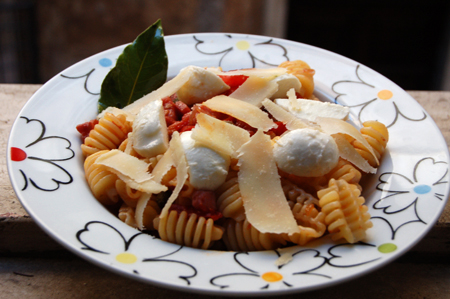
Pasta with Pancetta, Tomatoes, Red Wine and
Cheeses
4 ounces short pasta (radiatore, penne, campanelle)
1 tablespoon extra virgin olive oil
1 small onion, slivered
1/4 cup diced pancetta
1 cup cherry or grape tomatoes, quartered
2 fresh bay leaves
1/2 cup red wine
2 tablespoons capers, drained
2 tablespoons chopped fresh basil
1/4 cup reserved pasta cooking water
5 bocconcini (mozzarella balls, also called ciliegine)
slivers of Parmigiano-Reggiano
Bring a large kettle of well-salted water (2 -3 tablespoons salt) to a boil and cook pasta until al dente. Meanwhile, heat the oil in a skillet and add the onion and pancetta. Sauté until both are golden. Add the tomatoes and bay leaves and continue cooking to release the liquids form the tomatoes. Add the wine and bring to a simmer; reduce until almost evaporated. Add capers and basil with 1/4 cup of the pasta water. Add the cooked pasta and toss to coat with the sauce. Divide among two bowls and top with halved bocconcini and slivers of Parmigiano-Reggiano. Serve immediately.
Serves 2.
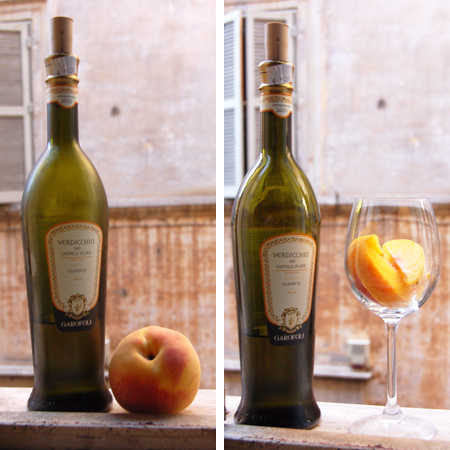
Peaches in Wine
peaches
wine
almond extract, optional
This “recipe” could not be easier. When the meal is done and there is still a bit of wine left in the bottle, slice your peaches into your wine glass and drizzle with some of the remaining wine. Seriously, it doesn’t get much better than this! Sometimes, we will add a drop of almond extract to the wine, especially if the peaches are not terribly sweet.
In Rome, they use the large yellow peaches in fizzy white wine, while in Tuscany, the peaches are white and the wine is red. Either way, it is a light treat after a heavy meal.



Susan Manfull
October 16, 2011 at 6:33 amIt's early here in Provence–I'm just sipping my first cup of tea–but, after reading your inspiring post ( with periodic pauses to wipe the drool from my iPad screen), I've planned tonight's dinner and tomorrow's! I have a friend visiting from Cotingac who brought some tomatoes from her garden and I have fresh mozzarella from Friday's market. We'll get the rest today for Pasta tonight! I'm hopeful tomorrow's market in Cadenet will have the mushrooms and, if not, surely Aix on Tuesday! Great post! And, by the way, the north-facing exposure was just a small challenge–brilliant photos!
Anonymous
October 16, 2011 at 10:08 amI stayed in that area when I was last in Rome too – PERFECT location! Your post brought back such nice memories, as I'm sure the recipes will too when they enter my kitchen! 🙂 Karin
Kirsten Honeyman
October 16, 2011 at 3:36 pmBravo – great recipes and photos! Love the description of the area you stayed in. Grazie!
Cocoa & Lavender
October 16, 2011 at 4:48 pm@ Susan: I do hope you can find the porcini (cepes) in either Cadenet or Aix! And I hope you enjoy the pasta, as well. Have you ever seen the haricots verts that tiny??
@ Karin: can you get fresh porcini in NYC?? If so, you can color me jealous!!
@ Kirsten: grazie lei! I so love reading your blog – such a joy to share our love of all things Mediterranean!
Anonymous
October 24, 2011 at 5:45 amDavid, that kitchen definitely looks like a place i could live in! The food look amazing too 🙂
Cocoa & Lavender
October 24, 2011 at 12:54 pmThanks, Jessica! The kitchen proves that you don't need an 8-burner professional stove to get some pretty great food on the table! And the neighborhood was, well, perfect!